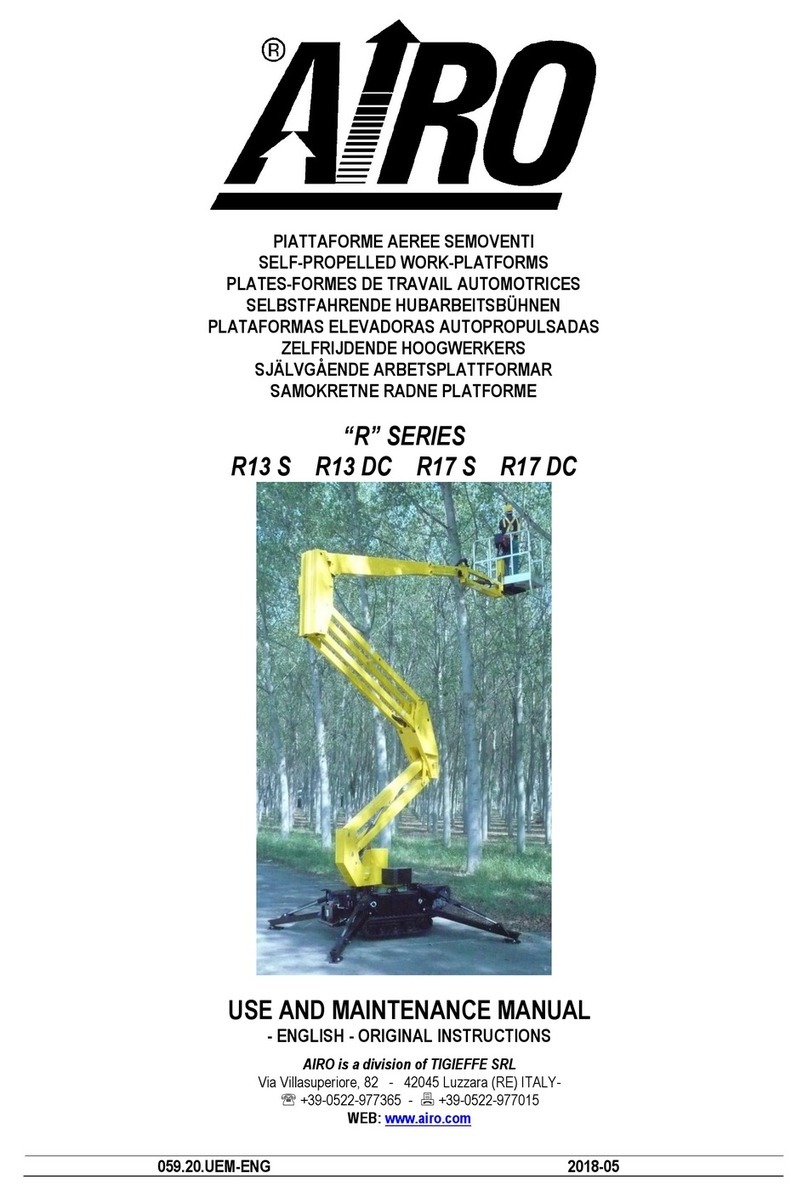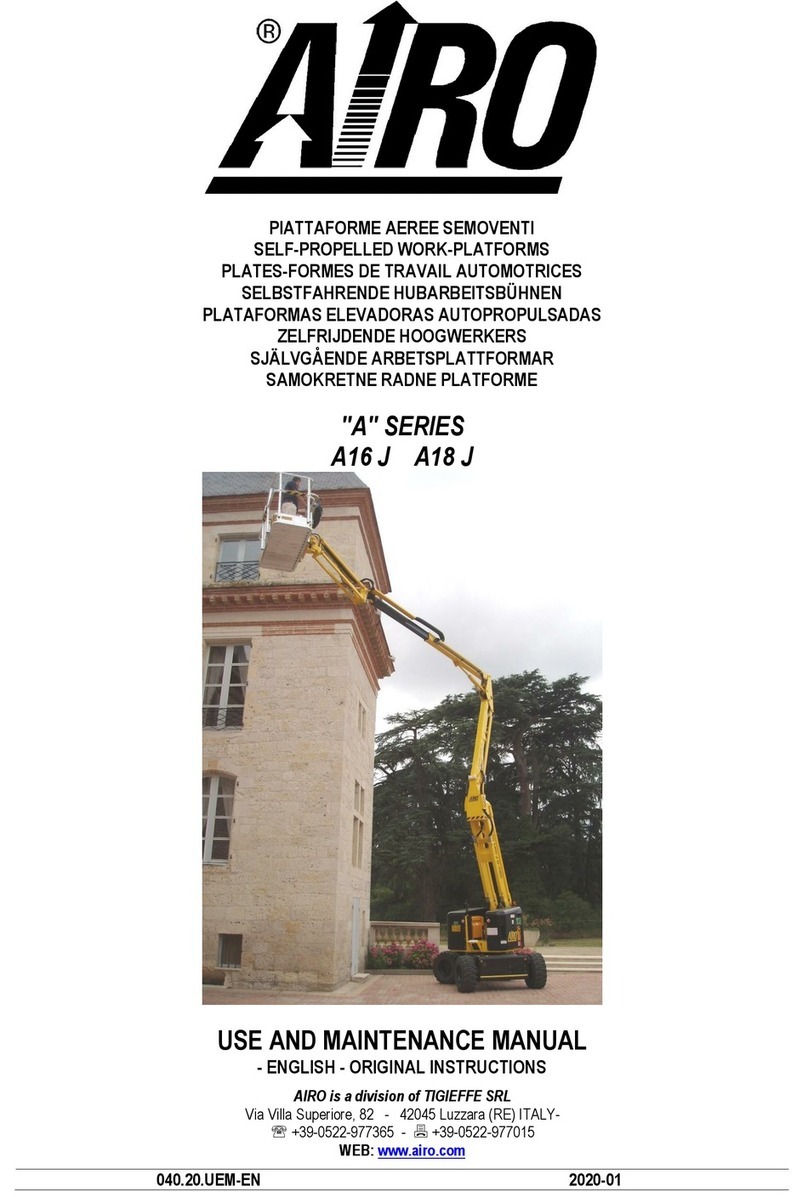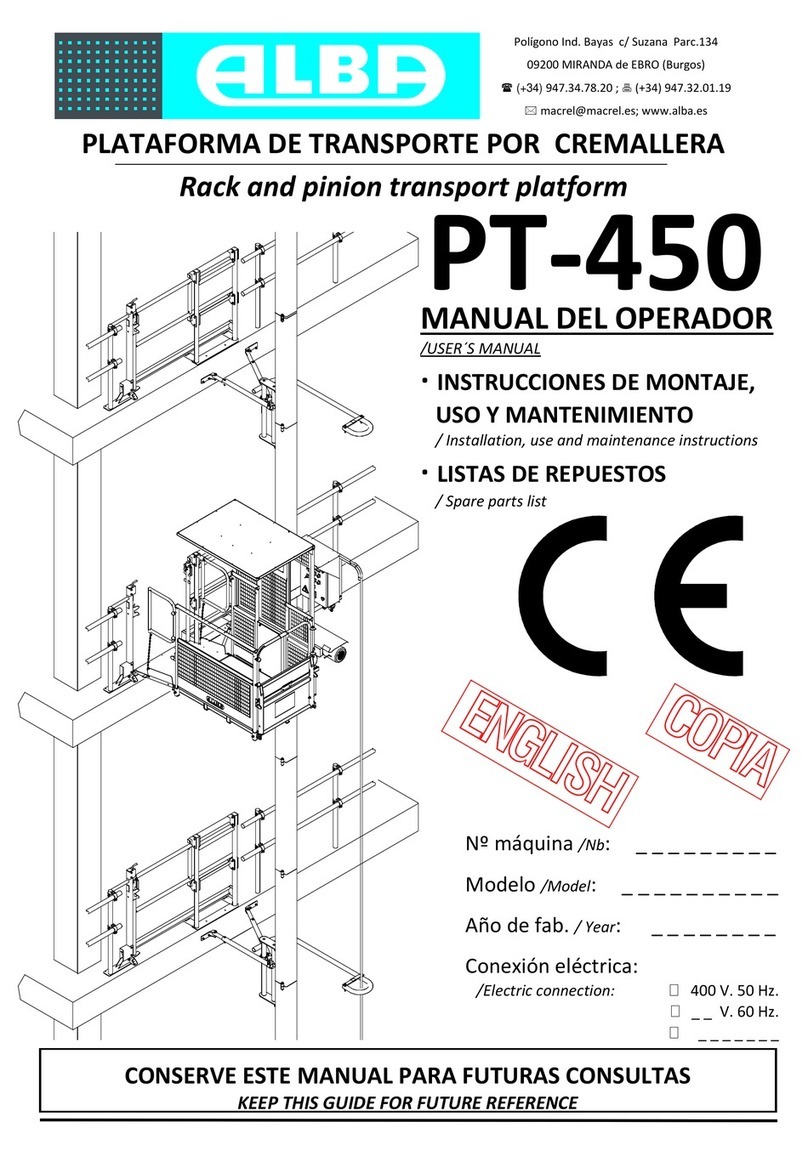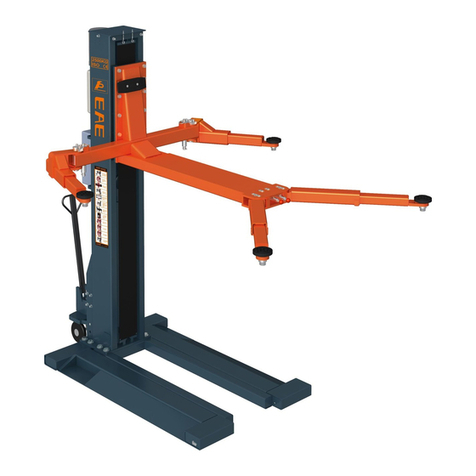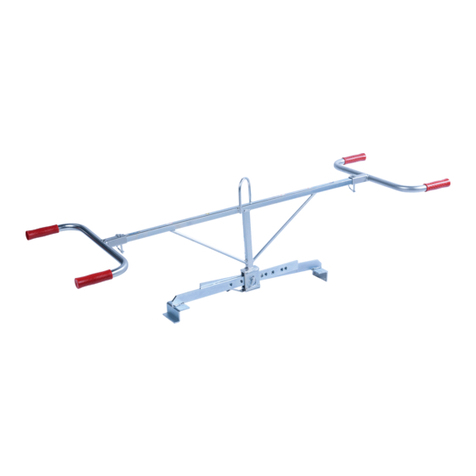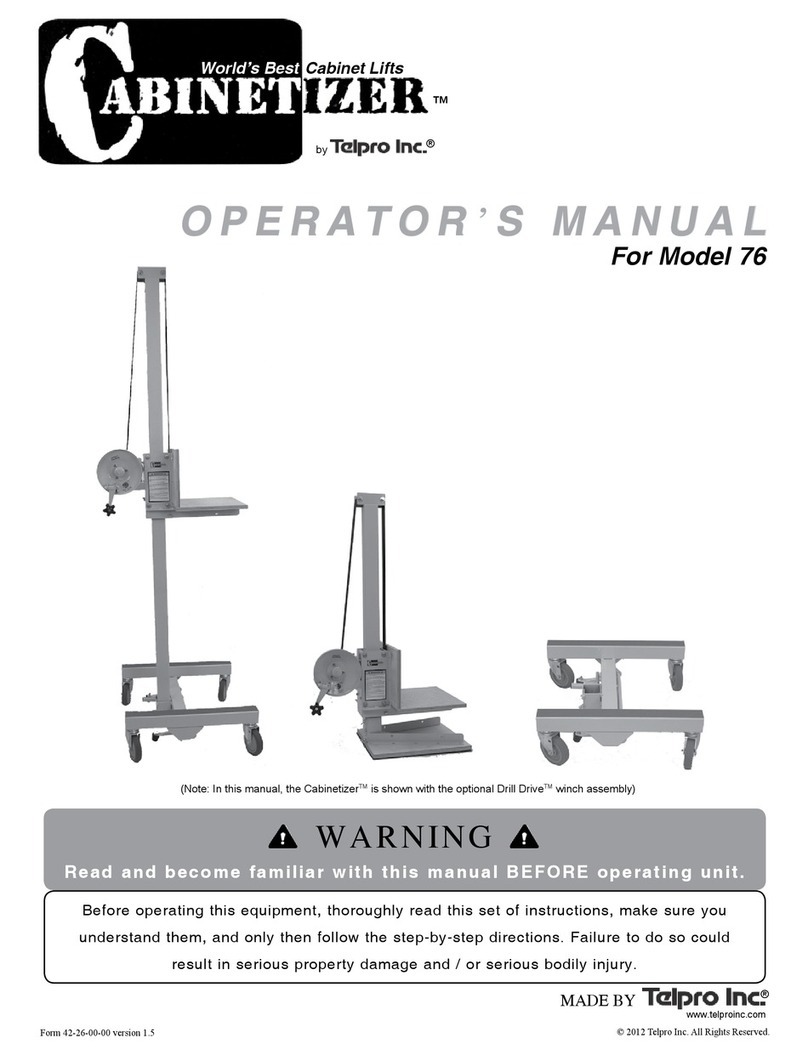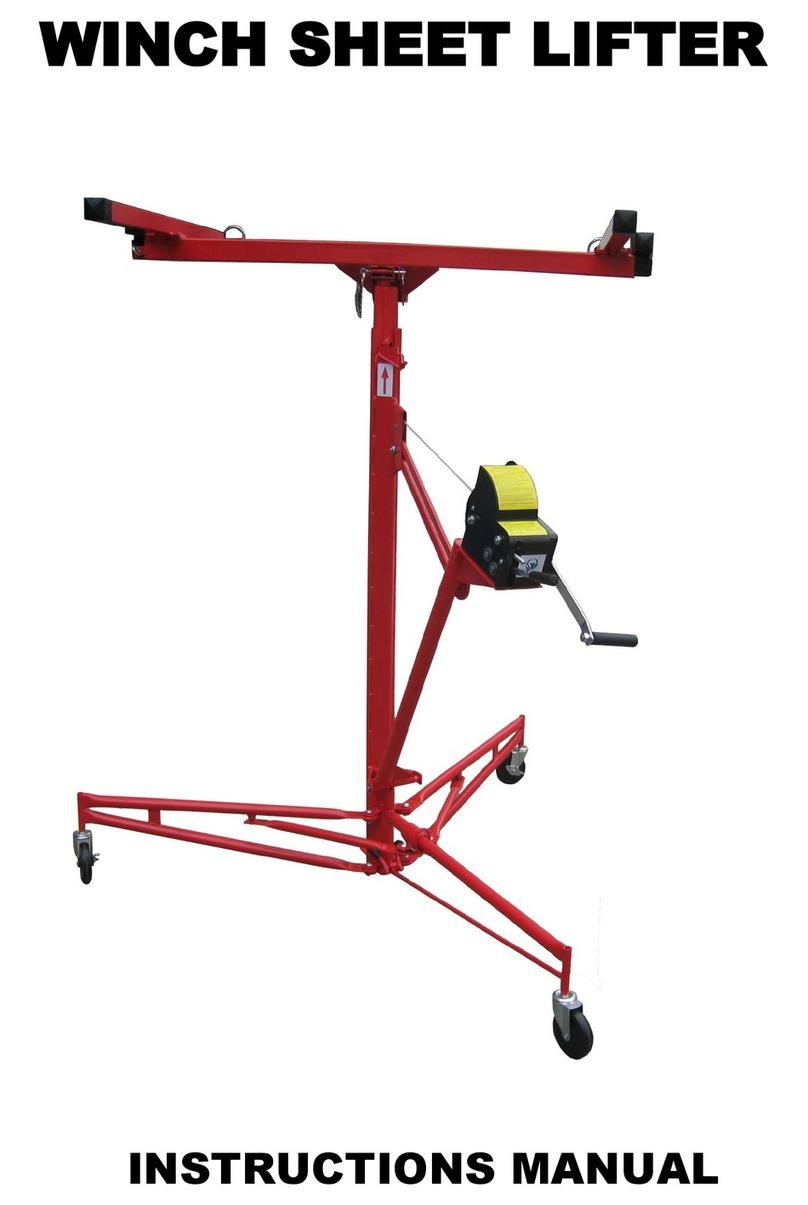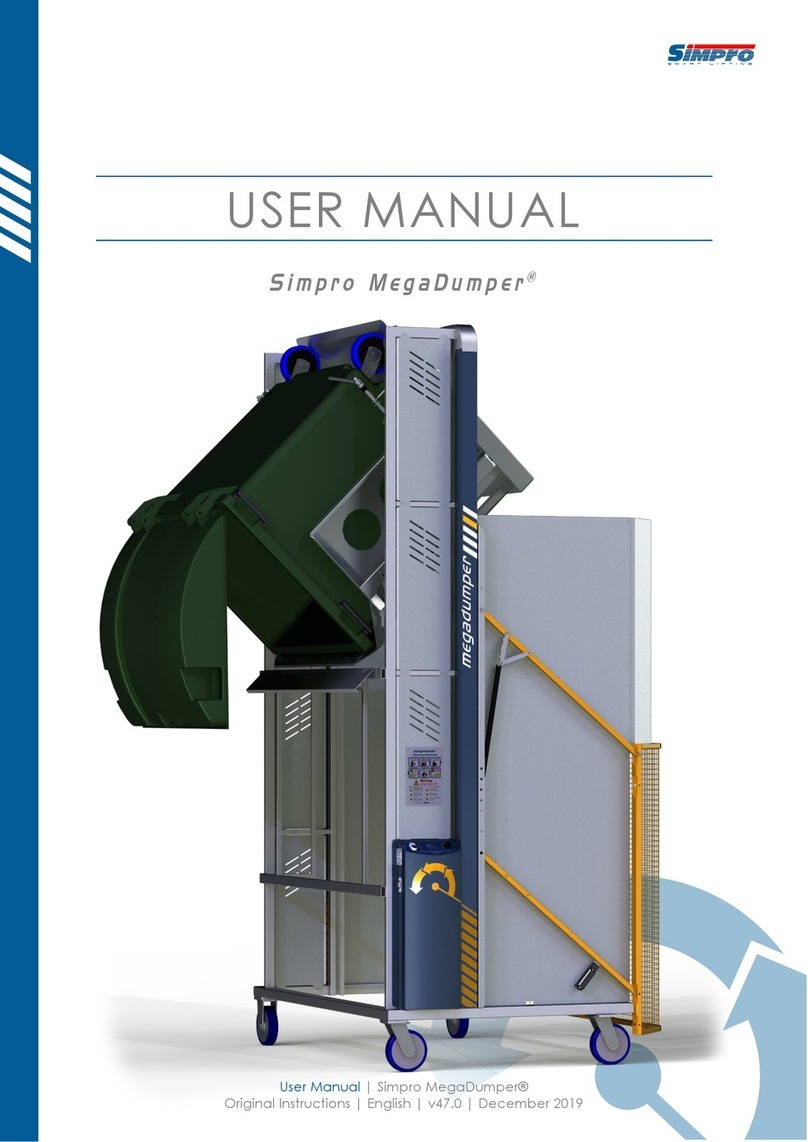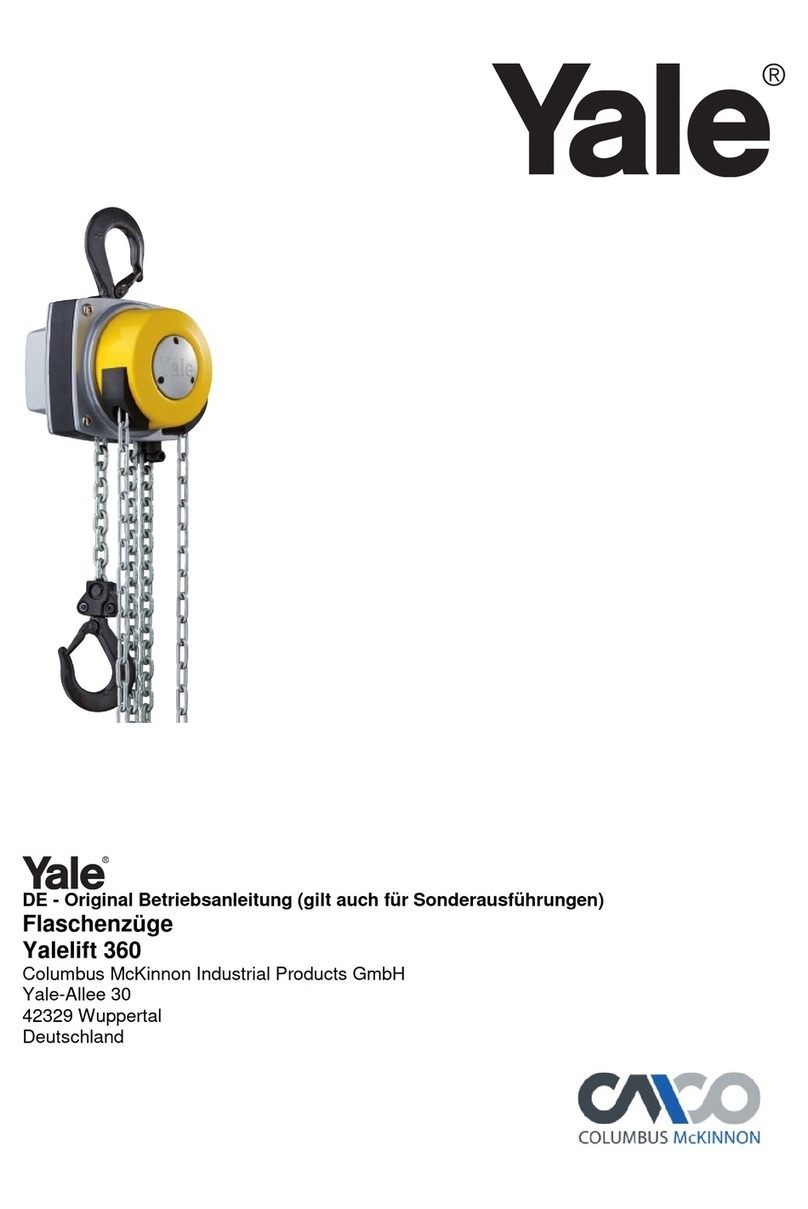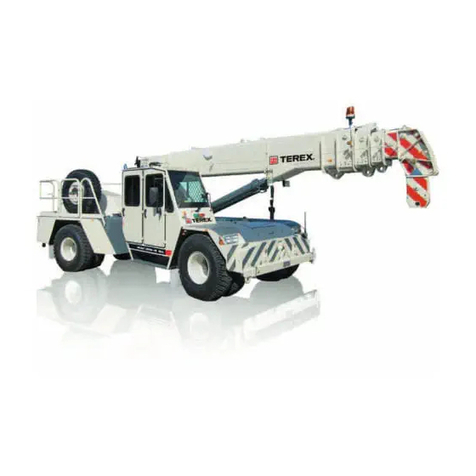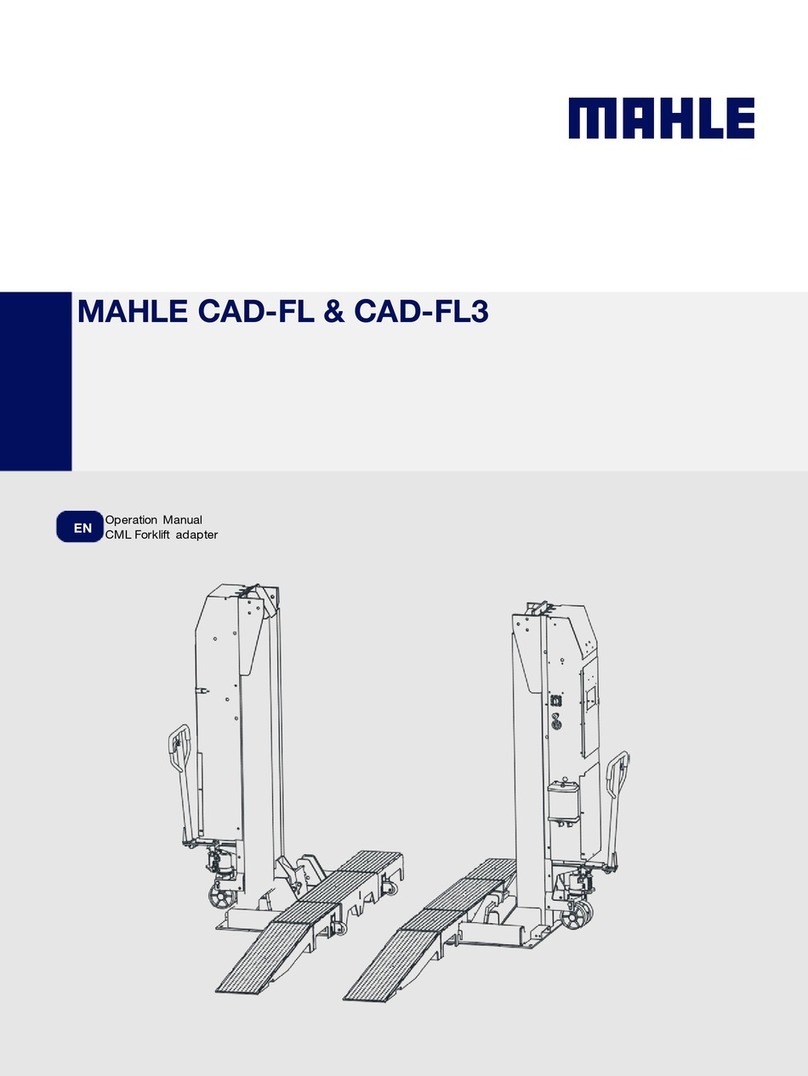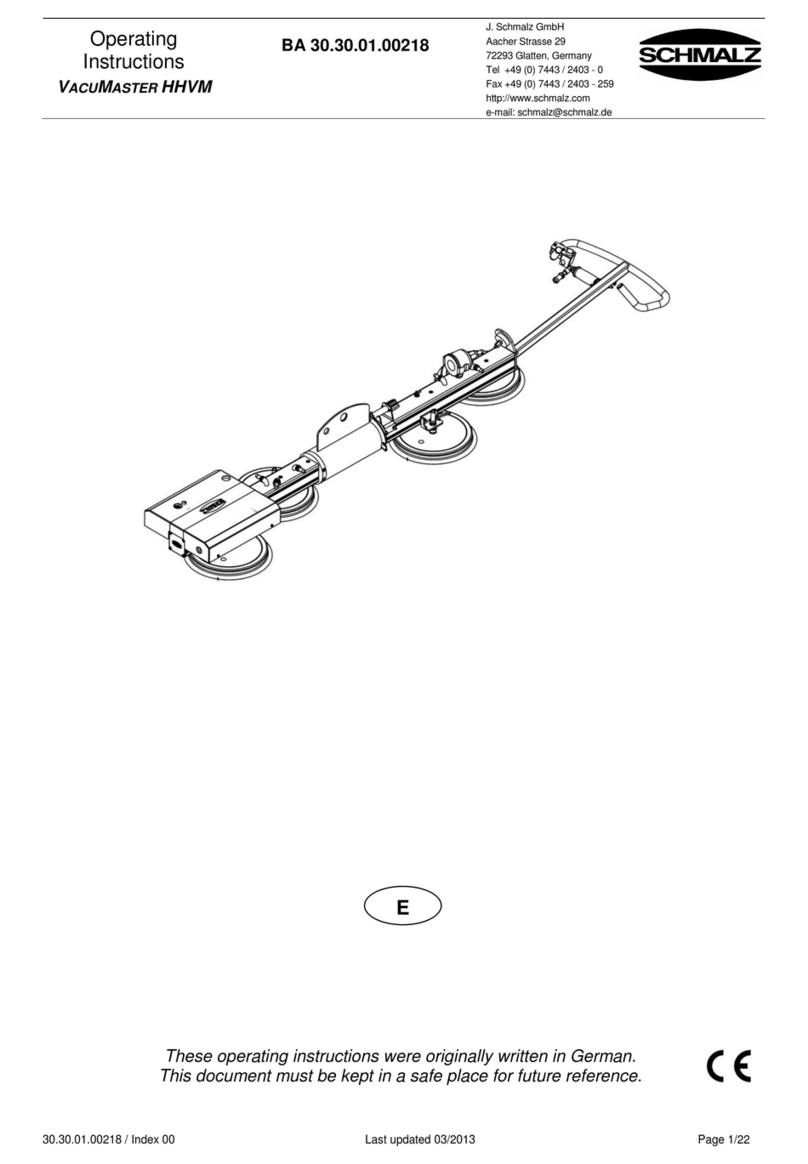TIGIEFFE Airo V Series User manual

PIATTAFORME AEREE SEMOVENTI
SELF-PROPELLED WORK-PLATFORMS
PLATES-FORMES DE TRAVAIL AUTOMOTRICES
SELBSTFAHRENDE HUBARBEITSBÜHNEN
PLATAFORMAS ELEVADORAS AUTOPROPULSADAS
ZELFRIJDENDE HOOGWERKERS
SJÄLVGÅENDE ARBETSPLATTFORMAR
SAMOKRETNE RADNE PLATFORME
"V" SERIES
V8 E V10 E
USE AND MAINTENANCE MANUAL
- ENGLISH - ORIGINAL INSTRUCTIONS
AIRO is a division of TIGIEFFE SRL
Via Villa Superiore, 82 - 42045 Luzzara (RE) ITALY-
+39-0522-977365 -+39-0522-977015
WEB: www.airo.com
070.20.UEM-EN
2020-01

Use and Maintenance Manual - Series V8 E V10 E
Page 2
Revision date
Description of revision
09-2014
•Manual issue.
01-2015
•CE conformity declaration updated.
10-2015
•Type of usable hydraulic oil updated.
•Added indication for spare parts. They must be original or approved by the manufacturer of
the machine in any way.
•Added "Leaving at height”.
01-2017
•Added new overload controller
02-2018
•Added possible code list on MDI indicator with relative description
05-2018
•Data sheets were added with double units of measurement of the US system (imperial unit).
•Changed Name and Surname of CEO.
07-2019
•Updated procedure description of commissioning declaration in Italy.
01-2020
•Updated normative references and certifying body

Use and Maintenance Manual - Series V8 E V10 E
Page 3
Tigieffe thanks you for purchasing a product of its range, and invites you to read this manual. Here you can find all the necessary
information for a correct use of the purchased machine; therefore, you are advised to follow the instructions carefully and to read the
manual thoroughly. The manual should be kept in a suitable place where no damage can occur to it. The content of this manual may
be modified without prior notice and further obligations in order to add changes and improvements to the units already delivered. No
reproduction or translation may take place without the written permission of the owner.
Contents:
1. INTRODUCTION..........................................................................................................................................6
1.1. Legal aspects............................................................................................................................................................. 6
1.1.1. Delivery of the machine ............................................................................................................................................... 6
1.1.2. Declaration of commissioning, first check, further periodical checks and transfers of ownership................................ 6
1.1.2.1. Declaration of commissioning and first check.............................................................................................................. 6
1.1.2.2. Further periodical checks............................................................................................................................................. 7
1.1.2.3. Transfers of ownership ................................................................................................................................................ 7
1.1.3. Operator training and information ................................................................................................................................ 7
1.2. Tests performed before delivery .............................................................................................................................. 7
1.3. Intended use............................................................................................................................................................... 7
1.3.1. Leaving at height.......................................................................................................................................................... 8
1.4. Description of the machine....................................................................................................................................... 8
1.5. Control panels............................................................................................................................................................ 9
1.6. Drive power ................................................................................................................................................................ 9
1.7. Machine life, demolition and decommissioning ................................................................................................... 10
1.8. Identification............................................................................................................................................................. 10
1.9. Location of main components................................................................................................................................ 11
2. TECHNICAL FEATURES OF STANDARD MACHINES............................................................................12
2.1. Model V8 E................................................................................................................................................................ 12
2.2. Model V10 E.............................................................................................................................................................. 15
2.3. Vibrations and noise................................................................................................................................................ 18
3. SAFETY PRECAUTIONS ..........................................................................................................................19
3.1. Personal protective equipment (PPE).................................................................................................................... 19
3.2. General safety norms.............................................................................................................................................. 19
3.3. Use instructions....................................................................................................................................................... 20
3.3.1. General...................................................................................................................................................................... 20
3.3.2. Handling..................................................................................................................................................................... 20
3.3.3. Operating procedures ................................................................................................................................................ 21
3.3.4. Wind speed according to Beaufort scale.................................................................................................................... 22
3.3.5. Pressure of the machine on ground and load-bearing capacity of ground................................................................. 23
3.3.6. High-voltage power lines............................................................................................................................................ 24
3.4. Dangerous situations and/or accidents................................................................................................................. 24
4. INSTALLATION AND PRELIMINARY CHECKS.......................................................................................25
4.1. Becoming acquainted with the machine................................................................................................................ 25
4.2. Preliminary operation checks................................................................................................................................. 25
5. HOW TO USE ............................................................................................................................................26
5.1. Platform control panel............................................................................................................................................. 26
5.1.1. Drive and steering...................................................................................................................................................... 28
5.1.2. Platform positioning movements................................................................................................................................ 29
5.1.2.1. Telescopic column lifting/lowering ............................................................................................................................. 29
5.1.2.2. Jib lifting/lowering....................................................................................................................................................... 29
5.1.2.3. Turret orientation (rotation) ........................................................................................................................................ 29
5.1.3. Other functions of the platform control panel. ............................................................................................................ 30
5.1.3.1. Manual horn............................................................................................................................................................... 30
5.1.3.2. Emergency stop button.............................................................................................................................................. 30
5.1.3.3. Warning lights............................................................................................................................................................ 30
5.1.3.3.1. Enabled control panel green warning light (ZA)......................................................................................................... 30
5.1.3.3.2. Red warning light: flat battery (ZB) ............................................................................................................................ 30
5.1.3.3.3. Danger red warning light (ZC).................................................................................................................................... 30

Use and Maintenance Manual - Series V8 E V10 E
Page 4
5.1.3.3.4. Overload red warning light (ZD)................................................................................................................................. 31
5.2. Ground control panel and controllers.................................................................................................................... 32
5.2.1. On-off key and control panel selector (A)................................................................................................................... 33
5.2.2. Emergency stop button (B) ........................................................................................................................................ 33
5.2.3. Battery indicator / Hour meter / Display (C) ............................................................................................................... 33
5.2.3.1. Display messages...................................................................................................................................................... 34
5.2.4. Battery charger warning light (D) ............................................................................................................................... 44
5.2.5. Platform control levers (E F G) .................................................................................................................................. 44
5.2.6. Emergency FACTORY OVERRIDE (H L).................................................................................................................. 44
5.3. Platform access ....................................................................................................................................................... 45
5.4. Machine start-up...................................................................................................................................................... 45
5.5. Machine stop............................................................................................................................................................ 46
5.5.1. Normal stop................................................................................................................................................................ 46
5.5.2. Emergency stop button.............................................................................................................................................. 46
5.6. Emergency controls ................................................................................................................................................ 47
5.6.1. Emergency controls from the ground control panel ................................................................................................... 47
5.6.2. Function FACTORY OVERRIDE. .............................................................................................................................. 47
5.6.3. Emergency manual controls ...................................................................................................................................... 47
5.7. Socket for electric tool connection (Optional) ...................................................................................................... 48
5.8. End of work .............................................................................................................................................................. 48
6. HANDLING AND CARRYING....................................................................................................................49
6.1. Handling ................................................................................................................................................................... 49
6.2. Carrying.................................................................................................................................................................... 50
6.3. Emergency towing of the machine......................................................................................................................... 51
7. MAINTENANCE.........................................................................................................................................52
7.1. Machine cleaning..................................................................................................................................................... 52
7.2. General maintenance............................................................................................................................................... 53
7.2.1. Various adjustments .................................................................................................................................................. 54
7.2.2. Greasing .................................................................................................................................................................... 55
7.2.3. Hydraulic circuit oil level check and change............................................................................................................... 56
7.2.3.1 Biodegradable hydraulic oil (Optional)....................................................................................................................... 57
7.2.3.2 Emptying.................................................................................................................................................................... 57
7.2.3.3 Filters......................................................................................................................................................................... 57
7.2.3.4 Washing..................................................................................................................................................................... 57
7.2.3.5 Filling ......................................................................................................................................................................... 57
7.2.3.6 Commissioning / check.............................................................................................................................................. 57
7.2.3.7 Mix ............................................................................................................................................................................. 58
7.2.3.8 Micro-filtration ............................................................................................................................................................ 58
7.2.3.9 Disposal..................................................................................................................................................................... 58
7.2.3.10 Topping up................................................................................................................................................................. 58
7.2.4. Hydraulic filter replacement ....................................................................................................................................... 59
7.2.5. Drive reduction gear oil level check and change........................................................................................................ 60
7.2.5.1 Checks in the use of synthetic biodegradable oil in drive reduction gears (Optional)................................................ 60
7.2.6. Telescopic column sliding blocks clearance adjustment............................................................................................ 61
7.2.7. Pressure relief valve operation check........................................................................................................................ 62
7.2.8. Operation check of the turret inclinometer................................................................................................................. 62
7.2.9. Adjustment of the overload controller (load cell)........................................................................................................ 64
7.2.10. Overload controller by-pass –ONLY FOR EMERGENCY OPERATIONS ................................................................ 66
7.2.11. Operation check of M1 microswitches ....................................................................................................................... 67
7.2.12. Operation check of dead-man pedal safety system................................................................................................... 68
7.2.13. Operation check of “dead-man” button safety system (optional)................................................................................ 68
7.3. Battery ...................................................................................................................................................................... 69
7.3.1. General instructions for battery.................................................................................................................................. 69
7.3.2. Battery maintenance.................................................................................................................................................. 70
7.3.3. Battery recharge ........................................................................................................................................................ 70
7.3.4. Battery charger: fault report ....................................................................................................................................... 72
7.3.5. Battery replacement................................................................................................................................................... 72
8. MARKS AND CERTIFICATIONS...............................................................................................................73

Use and Maintenance Manual - Series V8 E V10 E
Page 5
9. PLATES AND STICKERS..........................................................................................................................74
10. CHECK REGISTER ...................................................................................................................................76
11. TRANSFERS OF OWNERSHIP.................................................................................................................88
12. ELECTRIC DIAGRAM................................................................................................................................93
13. HYDRAULIC DIAGRAM ............................................................................................................................99
14. CONFORMITY DECLARATION. .............................................................................................................101

Use and Maintenance Manual - Series V8 E V10 E
Page 6
1. INTRODUCTION
This Use and Maintenance Manual provides general instructions concerning the complete range of machines indicated on the cover.
Therefore, the description of their components, as well as control and safety systems, may include parts not present on Your machine
since supplied on request or not available. In order to keep pace with the technical development AIRO-Tigieffe s.r.l. reserves the right
to modify the product and/or the use and maintenance manual at any time without updating the units already delivered.
1.1. Legal aspects
1.1.1. Delivery of the machine
Within EU (European Union) member countries the machine is delivered complete with:
▪Use and Maintenance manual in your language
▪CE mark applied on the machine
▪CE conformity declaration
▪Guarantee certificate
▪Declaration of internal testing
Only for Italy:
▪Instructions on commissioning declaration with INAIL and on the application for the first periodic check on the INAIL portal.
It is to be noted that the Use and Maintenance Manual is an integral part of the machine and a copy of this, together with copies of
the documents certifying that the periodical checks have been carried out, must be kept on board in its suitable container. In the
event of a transfer of ownership the machine must always be provided with its use and maintenance manual.
1.1.2. Declaration of commissioning, first check, further periodical checks and transfers of ownership
The legal obligations of the owner of the machine vary according to the country of commissioning. It is therefore recommended to
inquiry about the procedures in force in your country from the boards responsible for industrial safety. This manual contains a final
section called "Check register" for a better filing of documents and recording of any modifications.
1.1.2.1. Declaration of commissioning and first check
In ITALY the owner of the Aerial Platform must notify the use of the machine to the local competent INAIL and submit it to periodical
compulsory checks. The first of such checks is performed by the INAIL within sixty days from a request being made. In the event of
such time passing without the inspection being made, the employer can call in the ASL (Local Health Unit) or qualified public or
private services. Subsequent checks are made by the already-mentioned parties within thirty days from a request being made. In
the event of such time passing without these checks being made, the employer can call in qualified public or private services. The
checks are on a payment basis and the employer (machine owner) will be charged for them. For these checks, the territorial inspection
boards (ASL/USL or ARPA) and INAIL can be supported by qualified public or private services. The qualified private institutes acquire
the qualification of responsible for the public service and refer directly to the public structure that controls this function.
For the commissioning declaration in Italy it is necessary to login to the INAIL portal. Follow the instructions delivered together with
other documents during the machine delivery, as well as the information about the portal.
The INAIL will assign a serial number when the First Check is performed before completing the “technical identification sheet” on
which it indicates only the details obtained from the already-operating machine or obtainable from the instruction manual. Such
document shall form an integral part of the machine documentation.

Use and Maintenance Manual - Series V8 E V10 E
Page 7
1.1.2.2. Further periodical checks
Yearly checks are compulsory. In Italy the Aerial Platform owner must apply for a periodical check - by registered letter - to the local
competent inspection board (ASL/USL or other qualified public or private services) at least twenty days before the expiry of the year
from the last check.
NB: If a machine without a valid control document should be moved in an area outside the competence of the usual inspection board,
the owner of the machine must ask the inspection board, competent for the new territory where the machine is to be used, for the
annual check.
1.1.2.3. Transfers of ownership
In case of transfer of ownership (in Italy) the Aerial Platform new owner must notify the ownership of the machine to the local
competent inspection board (ASL/USL or ARPA or other qualified public or private services) by enclosing a copy of:
▪Declaration of conformity issued by the manufacturer.
▪Declaration of commissioning carried out by the first owner.
1.1.3. Operator training and information
The employer must ensure that the workers appointed to use the equipment are adequately and specifically trained so they are able
to use the Mobile Elevating Work Platform in a proper and safe way and also avoid the risks caused by other people.
1.2. Tests performed before delivery
Before being placed on the market, each MEWP undergoes the following tests:
▪Braking test
▪Overload test
▪Operating test
1.3. Intended use
The machine described in this use and maintenance manual is a self-propelled aerial platform intended for lifting persons and
materials (equipment and work materials) in order to carry out maintenance, installation, cleaning, painting, de-painting, sand-
blasting, welding operations, etc.
The max. capacity allowed (which varies according to the model –see paragraph “Technical features”) is divided as follows:
▪80 Kg for each person on board.
▪40 Kg for equipment.
▪The remaining load is represented by the material being worked.
In any case NEVER exceed the maximum capacity allowed as indicated in paragraph "Technical features”. Persons, tools and work
materials can be loaded on the platform only from the access position (platform lowered). It is absolutely forbidden to load persons,
tools and work materials on the platform when it is not in access position.
All loads must be positioned inside the cage; do not lift loads (even if complying with the maximum capacity allowed) hanging from
the platform or from the lifting structure.
Do not carry large-sized panels since they increase the resistance to wind force thus causing the machine to overturn.
While the machine is being displaced with lifted platform, no horizontal loads can be loaded onto the platform (operators on board
are not allowed to pull wires or ropes, etc.).
An overload controller stops the operation of the machine if the load on the platform exceeds by 20% approx. the nominal load (see
chapter "General use rules”) and platform is lifted.
The machine cannot be used in areas where road vehicles operate. Always surround the working area by means of suitable signs
when the machine is used in public areas.
Do not use the machine to tow trucks or other vehicles.
All types of machine use other than those for which it was designed must be approved in writing by the machine manufacturer
following a specific request on the part of the user.

Use and Maintenance Manual - Series V8 E V10 E
Page 8
Do not use the machine for purposes other than those for which it was designed, except after making a
request and having obtained written permission in this sense from the manufacturer
1.3.1. Leaving at height
The mobile elevating work platforms are not designed by taking into account the risks of the “leaving at height” because the only
access position considered is when the platform is completely lowered. For this reason, this activity is formally forbidden.
However, there are exceptional conditions in which the operator needs to access or leave the work platform not in the access position.
This activity is normally defined as “leaving at height”.
The risks connected to the “leaving at height” do not depend exclusively on the PLE (work elevating platform) characteristics; a
specific risk analysis carried out by the employer can authorize this specific use by taking into account:
▪The working environment characteristics;
▪The absolute prohibition to consider the work platform as an anchoring point for people working outdoors;
▪The use of the machine at xx% of its performances to avoid that additional forces created by a specific operation or bending
of the structure move away the access zone from the unloading zone. Provide for some tests in order to define these
limitations;
▪Provide for a specific evacuation procedure in case of emergency (for example: an operator always on the platform, one at
the ground control panel while a third operator leaves the lifted platform);
▪Provide for a specific training of the staff both as operator and transported staff;
▪Equip the unloading zone with all the devices that are necessary to avoid the risk of fall of the staff that accesses/leaves the
platform.
What said above is not a formal authorization of the manufacturer for the “leaving at height”, but it wants to supply information to the
employer - who is fully responsible for that - which can be useful for the planning of this exceptional activity.
1.4. Description of the machine
The machine described in this use and maintenance manual is a self-propelled elevating work platform equipped with:
▪motorized chassis equipped with wheels;
▪hydraulically driven rotating turret;
▪lifting system (extensible structure) composed of telescopic column with vertical extension and the “jib”;
▪operator platform (the max. capacity varies according to the model - see chapter "Technical features”).
The chassis is motorised to allow the machine to move even with lifted platform (see "Use instructions”) and has two rear driving
wheels and two front idle steering wheels. The rear wheels are equipped with parking brakes, positive logic type (when drive controls
are released brakes are automatically activated). On the chassis there are two fixed pot-hole guards which reduce the ground
clearance close to the wheels and they guarantee the stability of the machine with a wheel in a hole.
The turret rests on a turntable fixed to the chassis and can be oriented (rotated) by 360° non-continuous around the central axle of
the machine by means of irreversible endless screw.
The lifting system can be divided into two main structures:
▪the first, with vertical extension, consists of a telescopic column;
▪the second, consists of the terminal boom named “Jib”.
The hydraulic cylinders which move the extensible structure are single-acting and they are provided with normally sealed closed
valves directly flanged on the same. These devices allow the booms to remain in position even if one of the supply tubes accidentally
breaks.
The platform, hinged to the end of the “jib”, is equipped with guard-rails and toe-boards of a prescribed height (the height of the
guard-rails is 1100 mm; the height of the toe-boards is 150 mm; in the access area the toe board height is 100 mm). The
platform levelling is automatic and it is ensured by the jib tie rods.

Use and Maintenance Manual - Series V8 E V10 E
Page 9
1.5. Control panels
The machine is equipped with two control panels:
▪on the platform for normal use of the machine.
▪on the turret (or ground) there are the controls of emergency for the recovery of the platform, the emergency stop button, a
key-selector to select the control panel and to start the unit and an additional key-selector (FACTORY OVERRIDE) -
protected against the non-permissible use for the emergency ground recovery of a trapped and/or unconscious operator.
1.6. Drive power
The machines can be powered by an electro-hydraulic system composed of rechargeable batteries, electric pump and electric drive
motors equipped with automatic parking brake;
Both the hydraulic and the electric systems are equipped with all necessary protections (see electric and hydraulic circuit diagrams
annexed to this manual).

Use and Maintenance Manual - Series V8 E V10 E
Page 10
1.7. Machine life, demolition and decommissioning
The machine has been designed to last for 10 years in normal operating environments, if properly used and serviced. Within this
period, the manufacturer must carry out a complete inspection/overhaul.
If disposal of the unit is necessary, comply with current local regulations.
In Italy, the demolition/decommissioning must be notified to the local ASL / USL or ARPA.
The machine consists mainly of metal parts which are easy to be identified (steel for the most parts, and aluminium for the hydraulic
blocks); thus, we can state that the machine can be recycled at 90%.
European standards and those transposed by the member countries relating to respect for the environment
and the disposal of wastes envisage heavy administrative and penal fines in case of infringement.
In case of demolition/decommissioning, carefully keep to the provisions of applicable regulations, especially
as regards materials such as hydraulic oil and batteries.
1.8. Identification
In order to identify the machine, when spare parts and service are required, always mention the information given in the serial number
plate. Should this plate (as well as the various stickers applied on the machine) be lost or illegible, it is to be replaced as soon as
possible. In order to identify the machine when no plate is available the serial number is also stamped on the chassis. To locate the
plate and the stamp of the serial number, see the following picture. It is recommended to copy such data in the following boxes.
MODEL: _________________
CHASSIS: __________________
YEAR: __________________
Fig.1

Use and Maintenance Manual - Series V8 E V10 E
Page 11
1.9. Location of main components
The picture shows the machine and its own components.
1) Control panel
2) Ground emergency controls
3) Controllers;
4) Hydraulic oil tank
5) Hydraulic block of control;
6) Pot-hole guards;
7) Electric pump
8) Electric drive motors with brake;
9) Turret rotation hydraulic motor;
10) 230V plug (optional)
11) Spirit level (optional) for visual check
of machine levelling
12) Lifting cylinder telescopic column;
13) Jib lifting cylinder;
14) Solenoid valve proportional lower
control telescopic control (EV5);
15) Solenoid valve proportional lower
control jib (EV19)
16) Battery with central top up;
17) Power line plug (optional) and circuit
breaker switch (optional);
18) Inclinometer;
19) Limiting sensor of platform load (load
cell)
20) Turntable
21) Battery charger power supply plug;
22) Microswitch M1A;
23) Microswitch M1C.
Fig. 2

Use and Maintenance Manual - Series V8 E V10 E
Page 12
2. TECHNICAL FEATURES OF STANDARD MACHINES
THE TECHNICAL FEATURES OF THE PRODUCTS IN THE FOLLOWING PAGES CAN BE MODIFIED
WITHOUT PRIOR NOTICE
2.1. Model V8 E.
V8 E
Dimensions:
Maximum working height
8.1
m
26’ 6”
ft
Max. platform height
6.1
m
20”
ft
Ground clearance - central area of the chassis
55
mm
21.6”
in
Ground clearance - pot-hole area
30
mm
11.8”
in
Max. outreach from turntable centre
3.35
m
10’ 11”
ft
Turret rotation (not continuous)
355
°
355
°
Platform height for safety speed activation
< 2
m
<6’ 11”
ft
Internal steering radius
0.28
m
0’ 11”
ft
External steering radius
1.23
m
4’
ft
Maximum capacity (m)
200
Kg
440
lbs
Max. number of people on the platform (n) –indoors
2
2
Tool and material weight (me) (**) –indoors
40
Kg
88.2
lbs
Max. number of people on the platform (n) –outdoors
2
2
Tool and material weight (me) ** –outdoors
40
Kg
88.2
lbs
Maximum drive height
Max
Max
Maximum dimensions of platform (*****)
0.8 x 0.99
m
2’ 7” x 3’ 3”
ft
Max. hydraulic pressure
140
Bar
2030
psi
Tyre dimensions (****)
Ø 406 x 127
mm
15.9” x 5”
In
Tyre type (****)
Cushion soft
Cushion
soft
Transport dimensions
2,8 x 1,0 H=1,99
m
9’ 2” x 3’ 3”
H=6’ 6”
ft
Machine weight (unloaded) (*)
2720
Kg
6000
lbs
Stability limit:
Longitudinal inclination
2
°
2
°
Transversal inclination
2
°
2
°
Maximum manual force - indoors
400
N
89.9
lbf
Maximum manual force - outdoors
400
N
89.9
lbf
Maximum wind speed (***)
12.5
m/s
27.9
mph
Max. load per wheel
1350
Kg
2900
lbs
Performance:
Driving wheels
2
N
2
no
Max. drive speed
6
km/h
3.7
mph
Safety drive speed
0.6
km/h
0.4
mph
Oil tank capacity
30
Lt.
7.9
gal
Gradeability
25
%
25
%
Max. operating temperature
+50
°C
122
°F
Min. operating temperature
-15
°C
5
°F

Use and Maintenance Manual - Series V8 E V10 E
Page 13
Battery power
Voltage and standard battery capacity - Deep Cycle
24 / 280
V/Ah
24 / 280
V/Ah
Total electrolyte quantity of standard battery
4 x 10.3
Lt.
4 x 2.7
gal
Standard battery weight
4 x 47
Kg
400
lbs
Voltage and optional battery capacity - Drive Battery
24 / 320
V/Ah
24 / 320
V/Ah
Total electrolyte quantity of optional battery
4 x 11.4
Lt.
1.0 x 3.0
gal
Optional battery weight
4 x 52
Kg
4 x 114.10
lbs
Single-phase battery charger (HF)
24 / 25
V/A
24 / 25
V/A
Battery charger power supply mains voltage - single phase
230 –50
V - Hz
230 –50
V - Hz
Max. current absorbed by battery charger
12
A
12
A
Max. installed power
6.1
kW
8
hp
Electric pump power DC
4.5
kW
6.0
hp
Max. absorbed current
160
A
160
A
AC drive motors power
2 x 0.8
kW
2 x 1.0
hp
Max. current absorbed by each motor
2 x 50
A (DC)
2 x 50
A
(DC)
(*) In some cases, different limits can be fixed. It is recommended to comply with the data shown on the machine plate.
(**) me = m –(n x 80).
(***) Wind speeds higher or equal to 12.5 m/s indicate that the machines can also be used outdoors; Wind speeds equal to 0 m/s indicate that the machines can
be used INDOORS ONLY.
(****) Standard tyres: cushion soft no-marking.
(*****) Standard steel platform.

Use and Maintenance Manual - Series V8 E V10 E
Page 14

Use and Maintenance Manual - Series V8 E V10 E
Page 15
2.2. Model V10 E.
V10 E
Dimensions:
Maximum working height
9.86
m
32’ 4”
ft
Max. platform height
7.86
m
22’ 9”
ft
Ground clearance - central area of the chassis
55
mm
0’ 2”
in
Ground clearance - pot-hole area
30
mm
0’ 1”
in
Max. outreach from turntable centre
3.35
m
10’ 9”
ft
Turret rotation (not continuous)
355
°
355
°
Platform height for safety speed activation
< 2
m
<6’ 7”
ft
Internal steering radius
0.28
m
0’ 11”
ft
External steering radius
1.23
m
4”
ft
Maximum capacity (m)
200
Kg
440
lbs
Max. number of people on the platform (n) –indoors
2
2
Tool and material weight (me) (**) –indoors
40
Kg
88.2
lbs
Max. number of people on the platform (n) –outdoors
1
1
Tool and material weight (me) ** –outdoors
120
Kg
264.8
lbs
Maximum drive height
Max
Max
Maximum dimensions of platform (*****)
0.8 x 0.99
m
2’ 7” x 3’ 3”
ft
Max. hydraulic pressure
140
Bar
2030
psi
Tyre dimensions (****)
Ø 406 x 127
mm
15.9” x 5”
in
Tyre type (****)
Cushion soft
Cushion soft
Transport dimensions
2,8 x 1,0
H=1,99
m
9’ 2” x 3’ 3”
H= 6’ 7”
ft
Machine weight (unloaded) (*)
2770
Kg
6100
lbs
Stability limit:
Longitudinal inclination
2
°
2
°
Transversal inclination
2
°
2
°
Maximum manual force - indoors
400
N
90
lbf
Maximum manual force - outdoors
200
N
45
lbf
Maximum wind speed (***)
12.5
m/s
28
mph
Max. load per wheel
1350
Kg
2900
lbs
Performance:
Driving wheels
2
N
2
no
Max. drive speed
6
km/h
3.7
mph
Safety drive speed
0.6
km/h
0.4
mph
Oil tank capacity
30
Lt.
7
gal
Gradeability
25
%
25
%
Max. operating temperature
+50
°C
122
°F
Min. operating temperature
-15
°C
5
°F

Use and Maintenance Manual - Series V8 E V10 E
Page 16
Battery power
Voltage and standard battery capacity - Deep Cycle
24 / 280
V/Ah
24 / 280
V/Ah
Total electrolyte quantity of standard battery
4 x 10.3
Lt.
4 x 2.7
gal
Standard battery weight
4 x 47
Kg
400
lbs
Voltage and optional battery capacity - Drive Battery
24 / 320
V/Ah
24 / 320
V/Ah
Total electrolyte quantity of optional battery
4 x 11.4
Lt.
1.0 x 3.0
gal
Optional battery weight
4 x 52
Kg
4 x 114.10
lbs
Single-phase battery charger (HF)
24 / 25
V/A
24 / 25
V/A
Battery charger power supply mains voltage - single phase
230 –50
V - Hz
230 –50
V - Hz
Max. current absorbed by battery charger
12
A
12
A
Max. installed power
6.1
kW
8
hp
Electric pump power DC
4.5
kW
6.0
hp
Max. absorbed current
160
A
160
A
AC drive motors power
2 x 0.8
kW
2 x 1.0
hp
Max. current absorbed by each motor
2 x 40
A
(DC)
2 x 50
A
(DC)
(*) In some cases, different limits can be fixed. It is recommended to comply with the data shown on the machine plate.
(**) me = m –(n x 80).
(***) Wind speeds higher or equal to 12.5 m/s indicate that the machines can also be used outdoors; Wind speeds equal to 0 m/s indicate that the machines can
be used INDOORS ONLY. The V10 E can be used outdoors with only one person on the platform.
(****) Standard tyres: cushion soft no-marking.
(*****) Standard steel platform.

Use and Maintenance Manual - Series V8 E V10 E
Page 17

Use and Maintenance Manual - Series V8 E V10 E
Page 18
2.3. Vibrations and noise
Noise tests have been carried out under the most unfavourable conditions to study the effects on the operator. The level of acoustic
pressure weighed (A) at work places does not exceed 70dB(A) for each electrical model.
For the models equipped with diesel motor generator, the level of acoustic pressure weighed (A) at work places does not exceed
106dB(A), the level of acoustic pressure at ground control panel does not exceed 85dB(A), the level of acoustic pressure at platform
control panel does not exceed 78bD(A).
As to vibrations in ordinary working conditions:
▪The average weighted quadratic value in frequency of the acceleration which the upper members have to withstand is below
2.5 m/sec² for each of the models to which this Use and Maintenance manual refers.
▪The average weighted quadratic value in frequency of the acceleration which the body has to withstand is below 0.5 m/sec²
for each of the models to which this Use and Maintenance manual refers.

Use and Maintenance Manual - Series V8 E V10 E
Page 19
3. SAFETY PRECAUTIONS
3.1. Personal protective equipment (PPE)
Always wear personal protective equipment according to current regulations concerning industrial health and safety (in particular,
hard hat and safety shoes are COMPULSORY).
It is the operator or safety manager’s responsibility to choose the personal protective equipment (PPE) depending on the activity to
be carried out. For their correct use and maintenance, refer to the equipment manuals themselves.
The use of safety harness is not compulsory except in certain countries with specific regulations. In Italy, the consolidation act on
safety, Law Decree 81/08, has made the use of a safety harness mandatory.
The harness is attached to one of the anchorages reported by labels, as in the following picture.
Fig. 3
3.2. General safety norms
▪Only adults (18 years old), after carefully reading this manual, are allowed to use the machine. The employer is
responsible for training.
▪The platform is intended for people carriage; therefore, it is necessary to comply with the current local regulations
relevant to this class of machines (see paragraphs 1).
▪At least two users must operate the machine, one of them on the ground, able to carry out the emergency
operations described in this handbook.
▪Always keep the machine at a safety distance from power lines as indicated in the next chapters.
▪Use the machine according to the capacity values indicated in the technical features section. The identification
plate shows the maximum number of people allowed on the platform at any one time, the maximum capacity and
the tool and material weight. Never exceed the indicated figures.
▪Do NOT use the framework of the platform or any of its elements for grounding connections while welding on the
platform.
▪It is absolutely forbidden to load and/or unload persons and/or material with platform not in the access position.
▪It is the machine owner and/or safety manager’s responsibility to check that the maintenance and repair
operations are carried out by skilled personnel.

Use and Maintenance Manual - Series V8 E V10 E
Page 20
3.3. Use instructions
3.3.1. General
The electric and hydraulic circuits are provided with safety devices, calibrated and sealed by the manufacturer:
DO NOT TAMPER WITH AND MODIFY THE CALIBRATION OF ANY COMPONENT OF THE ELECTRIC AND
HYDRAULIC SYSTEMS.
▪The machine must be used only in areas well lit up, checking that the ground is flat and firm. The machine may not
be used if the lighting conditions are not sufficient. The machine is not equipped with any lightening system.
▪Before using the machine check its integrity and conservation state.
▪During maintenance operations do not dispose of any waste materials in the environment, but comply with current
regulations.
▪Do not carry out any service or maintenance operations when the machine is connected to the mains supply. Follow
the instructions given in the following paragraphs.
▪Do not approach the electric and hydraulic system components with sources of heat or flames.
▪Do not increase the max. allowed height by means of scaffolds, ladders or other.
▪With the machine lifted, do not fasten the platform to any structure (beams, pillars or wall).
▪Do not use the machine as a crane, hoist or lift.
▪Protect the machine (in particular the platform control panel by means of the specially provided cover- optional) and
the operator when working in adverse environmental conditions (painting, de-painting, sand-blasting, washing, etc.).
▪Using the machine in bad weather conditions is forbidden; in particular, wind speeds must not exceed the limits
indicated in the Technical specifications (to measure speeds, see the following chapters).
▪Machines with a wind speed limit of 0 m/s are to be used indoors only.
▪In the event of rain or in parking condition always protect the platform control panel by means of the specially provided
cap (optional).
▪Do not use the machine in areas where risks of fire or explosion exist.
▪Do not use pressurized water jets (high-pressure cleaners) to wash the machine.
▪Overloading the work platform is forbidden.
▪Avoid knocks and/or contacts with other vehicles and fixed structures.
▪Leaving or accessing the work platform is forbidden unless this is in the position required for access or leaving (see
the “Accessing the platform” chapter).
3.3.2. Handling
▪Before handling the machine check that the connection plugs are disconnected from the power supply source. Always
check the cable position during handling if the machine is powered with a 230V electrical pump.
▪In order to avoid any instability, use the machine on regular and firm grounds. To prevent the machine from
overturning, comply with the max. gradeability values indicated in the Technical data section under paragraph "Stability
limits". However, movements on inclined grounds are to be carried out with the utmost caution.
▪As soon as the platform is lifted (the tolerance varies from model to model) the safety drive speed is automatically
activated (all models of this handbook have passed the stability Tests in compliance with standard EN280).
▪Drive the machine with lifted platform only on flat grounds, verifying the absence of holes or steps on the floor and
bearing in mind the overall dimensions of the machine.
▪While driving the machine with lifted platform the operators are not allowed to place horizontal loads onto the platform
(operators on board must not pull ropes, wires, etc.).
▪The machine must not be used directly for road transport. Do not use it for material transport (see paragraph “Intended
use”).
▪Check that in the operating area there are not obstacles or other dangerous elements.
▪Pay particular attention to the area above the machine during lifting to avoid any crushing and collisions.
▪During operation keep your hands in safety position, the driver has to place them as shown in picture A or B while the
transported operator has to keep them as shown in picture C.
This manual suits for next models
2
Table of contents
Other TIGIEFFE Lifting System manuals
Popular Lifting System manuals by other brands
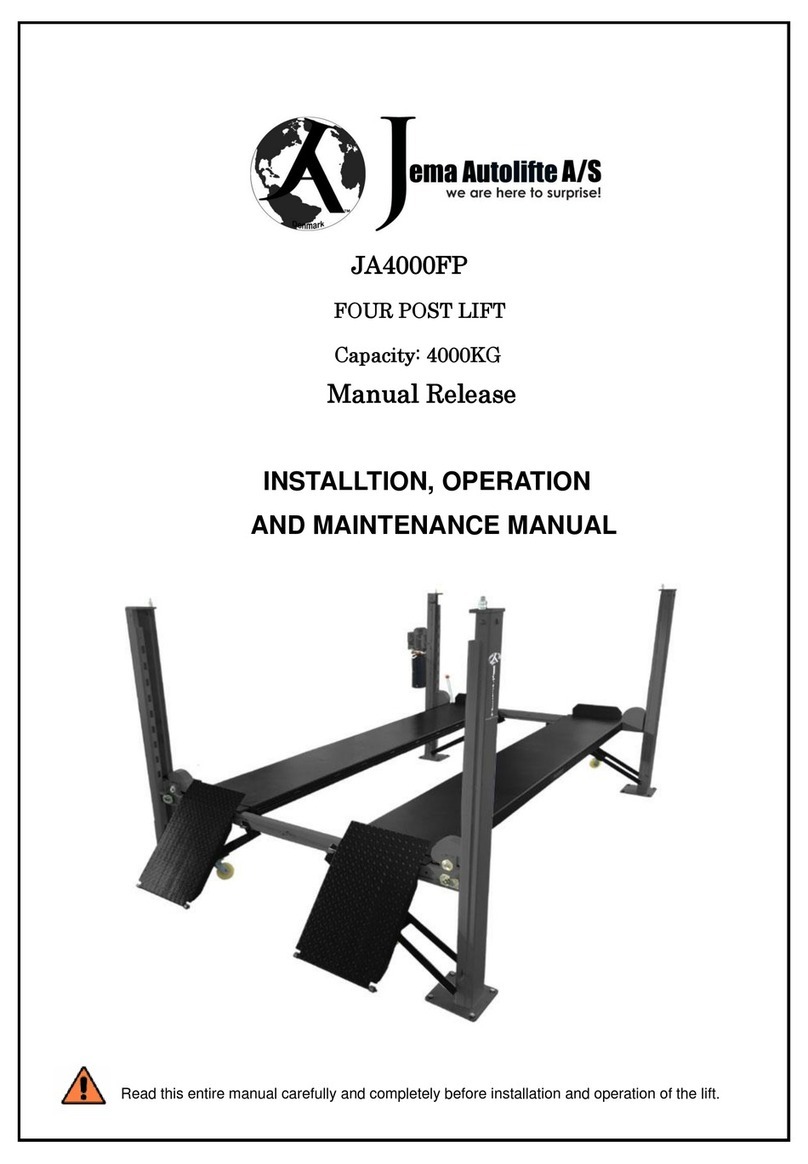
Jema Autolifte
Jema Autolifte JA4000FP Installtion, Operation and Maintenance Instructions

ATH-Heinl
ATH-Heinl Cross Lift 35 OG user manual
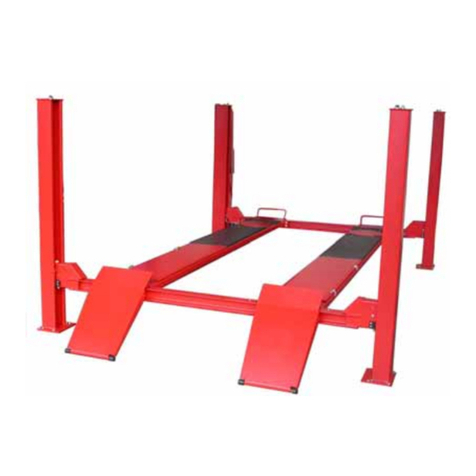
Nussbaum
Nussbaum 4.40 ND Operating Instruction and Documentation
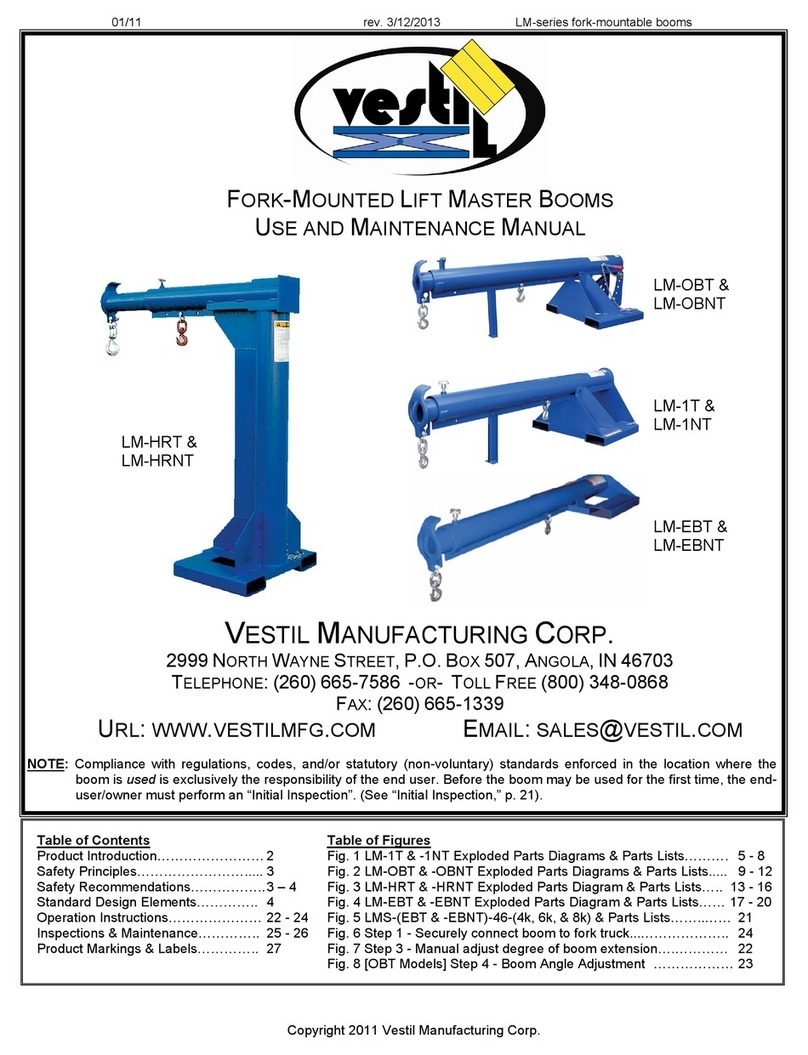
Vestil
Vestil LM-HRT Use and maintenance manual

Haulotte
Haulotte H28TJ+ Maintenance book
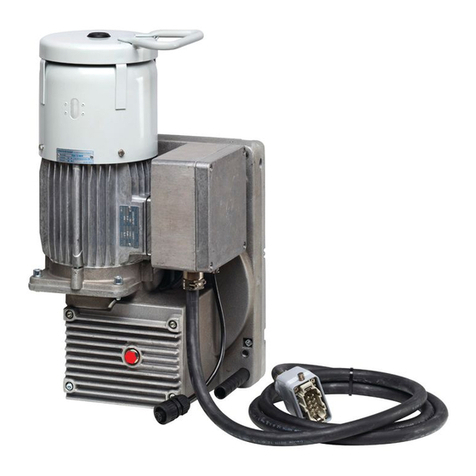
Tractel
Tractel tirak L 500 P Series Original Operation and Installation Manual
